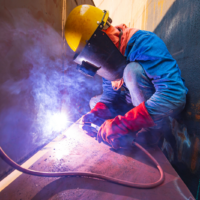The Dangers of Underwater Welding in The Oil Industry

Underwater welding or hyperbaric welding is carried out for the maintenance of partially or fully submerged marine infrastructures. The structures that an offshore underwater welder works on include large ships, underwater habitats, oil rigs, pipelines, and nuclear power centers.
The basic welding equipment and techniques for welding on dry land and welding underwater are not very dissimilar except for the typical training and certification required to work as an underwater welder. The inherent danger in the highly specialized field of underwater welding means that a welder needs years of extensive training to acquire knowledge and skill along with an accredited dive school certification.
Categories of Underwater Welding
There are two main types of underwater welding:
- Wet Underwater Welding
This process involves low carbon steel and commonly uses shielded metal arc welding with a waterproof electrode. Some of the other processes use flux-cored arc welding and friction welding.
- Dry Underwater Welding
This welding process uses a pressurized chamber that is filled with a mixture and sealed around the structure that needs welding. The dry welding process uses the gas tungsten arc welding power source with high integrity of welding.
Hazards Faced by Underwater Welders
Underwater welding is one of the most hazardous careers in the offshore oil and gas industry as underwater welders encounter some of the most dangerous work environments each time that they perform their job. Some of these hazards may cause long-term health issues and can even prove to be fatal. Below are a few of these dangers that welders face while working underwater:
- Hypothermia
The underwater temperature can get very low, causing conduction of warmth away from a diving welder’s body. Underwater welders run the risk of organ failure and metabolism issues if they stay for extended periods in the freezing water. Wearing insulated rubber wetsuits is critical for underwater welders to protect themselves from the extreme cold.
- Decompression Sickness
The quick change in pressure when a diver ascends too quickly from down below to the surface of the water can result in nitrogen bubbles entering the bloodstream of the diver. These bubbles can then spread through the diver’s body resulting in several adverse symptoms, such as joint pain, rashes, paralysis, and even death.
- Drowning
Any underwater profession carries with it an inherent risk of drowning. Although underwater welders are some of the best certified professional divers; faulty or ill-maintained equipment and getting tangled in their own lines can result in drowning incidents.
- Hearing Impairment
Having to spend a lot of time under high pressure due to the nature of their job, underwater welders can experience temporary or even permanent hearing loss. The possibility of ear and lung damage is also high for these divers.
- Electric Shock
The risk of electrocution remains ever-present for an underwater welder if the welding equipment is not properly adapted to work under the water. Properly insulated welding equipment with waterproof electrodes is needed for underwater work. All equipment needs to undergo rigorous testing as water and electrical equipment can prove to be a fatal combination.
- Marine Wildlife
Underwater welders need strong lights to see the structures they are working on at great depths under the water. These lights attract plankton which in turn attract fish and their predators. Underwater welders need to be wary of deep-sea predators like eels, sharks, and other marine wildlife that could attack them.
- Explosions
Underwater welding creates pockets of oxygen and hydrogen that pose a serious threat to the welders. These gases could potentially ignite, causing explosions that could prove fatal for the welders as well as offshore oil and gas workers.
Reducing the Risks Inherent in Underwater Welding
Underwater welders need to be on constant alert and fully aware of the potential hazards of their work as well as in their dangerous and unpredictable surroundings, to minimize the likelihood of any accidents. They must scrupulously follow all safety protocols before, during, and after their underwater work.
Despite all the technological advancements in underwater and deep-sea exploration, there is no technology available as of now that can replace an underwater welder. Underwater welding is a specialized job that is crucial for many industries, leading to a constant high demand for these specially trained welders who enjoy the rare combination of the perks that their jobs entail, namely, challenging work and attractive pay.
Louisiana Oilfield Injury Attorneys
At the Trainor Law Firm, LLC, our offshore injury attorneys have an in-depth understanding of the complex laws governing oilfield injuries and damages. We can skillfully evaluate the accident that caused your injuries, and help you recover the maximum possible compensation that you deserve.
We understand the difficulties you may face after an underwater welding accident and provide a free case review if you are seeking damages for an underwater welding injury. If you are the victim of an oilfield accident, it is important to have a skilled attorney in your corner. Call our firm today at 985-900-2250 or contact us online to learn how we can help you.



